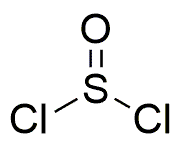Thionyl chloride is widely utilized in research focused on:
- Synthesis of Chemicals: It serves as a key reagent in the synthesis of various organic compounds, including sulfides and phosphonates, making it invaluable in pharmaceutical and agrochemical industries.
- Chlorination Reactions: This compound is effective in chlorinating alcohols and amines, which is essential for producing chlorinated derivatives used in further chemical reactions.
- Production of Sulfur Dioxide: Thionyl chloride can be used to generate sulfur dioxide, a crucial component in various industrial processes, including the production of sulfuric acid.
- Laboratory Applications: In research labs, it is often used for the preparation of thionyl derivatives, helping chemists explore new compounds and their potential applications.
- Environmental Applications: It plays a role in the synthesis of environmentally friendly pesticides, contributing to sustainable agricultural practices.
General Information
Properties
Safety and Regulations
Applications
Thionyl chloride is widely utilized in research focused on:
- Synthesis of Chemicals: It serves as a key reagent in the synthesis of various organic compounds, including sulfides and phosphonates, making it invaluable in pharmaceutical and agrochemical industries.
- Chlorination Reactions: This compound is effective in chlorinating alcohols and amines, which is essential for producing chlorinated derivatives used in further chemical reactions.
- Production of Sulfur Dioxide: Thionyl chloride can be used to generate sulfur dioxide, a crucial component in various industrial processes, including the production of sulfuric acid.
- Laboratory Applications: In research labs, it is often used for the preparation of thionyl derivatives, helping chemists explore new compounds and their potential applications.
- Environmental Applications: It plays a role in the synthesis of environmentally friendly pesticides, contributing to sustainable agricultural practices.
Documents
Safety Data Sheets (SDS)
The SDS provides comprehensive safety information on handling, storage, and disposal of the product.
Product Specification (PS)
The PS provides a comprehensive breakdown of the product’s properties, including chemical composition, physical state, purity, and storage requirements. It also details acceptable quality ranges and the product's intended applications.
Certificates of Analysis (COA)
Search for Certificates of Analysis (COA) by entering the products Lot Number. Lot and Batch Numbers can be found on a product’s label following the words ‘Lot’ or ‘Batch’.
*Catalog Number
*Lot Number
Certificates Of Origin (COO)
This COO confirms the country where the product was manufactured, and also details the materials and components used in it and whether it is derived from natural, synthetic, or other specific sources. This certificate may be required for customs, trade, and regulatory compliance.
*Catalog Number
*Lot Number
Safety Data Sheets (SDS)
The SDS provides comprehensive safety information on handling, storage, and disposal of the product.
DownloadProduct Specification (PS)
The PS provides a comprehensive breakdown of the product’s properties, including chemical composition, physical state, purity, and storage requirements. It also details acceptable quality ranges and the product's intended applications.
DownloadCertificates of Analysis (COA)
Search for Certificates of Analysis (COA) by entering the products Lot Number. Lot and Batch Numbers can be found on a product’s label following the words ‘Lot’ or ‘Batch’.
*Catalog Number
*Lot Number
Certificates Of Origin (COO)
This COO confirms the country where the product was manufactured, and also details the materials and components used in it and whether it is derived from natural, synthetic, or other specific sources. This certificate may be required for customs, trade, and regulatory compliance.


